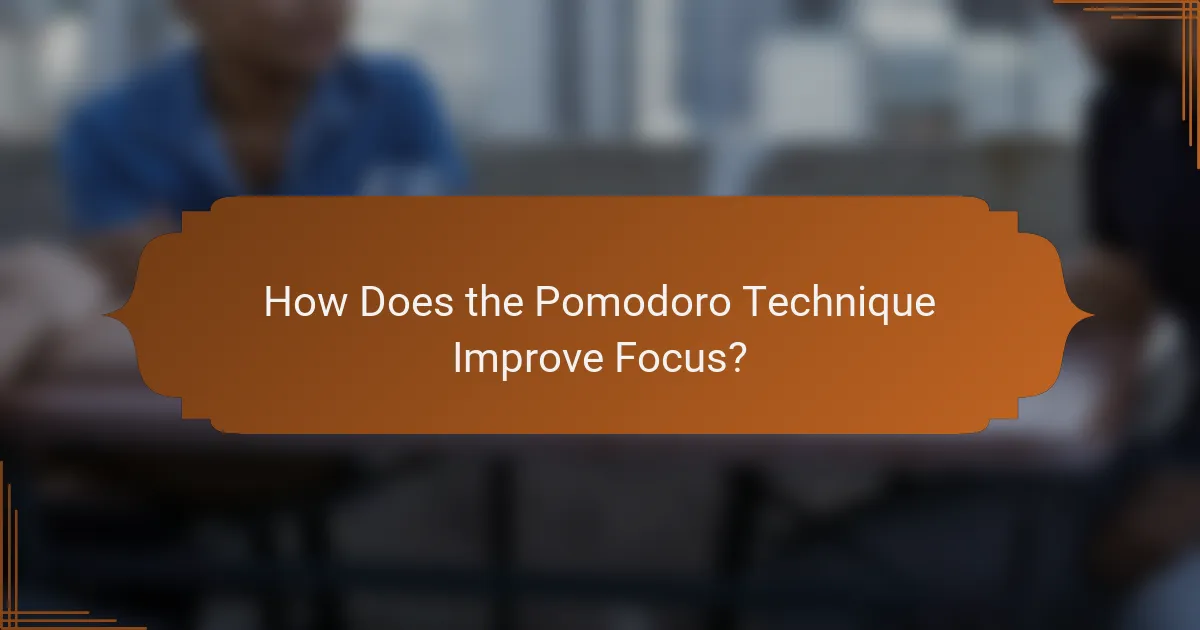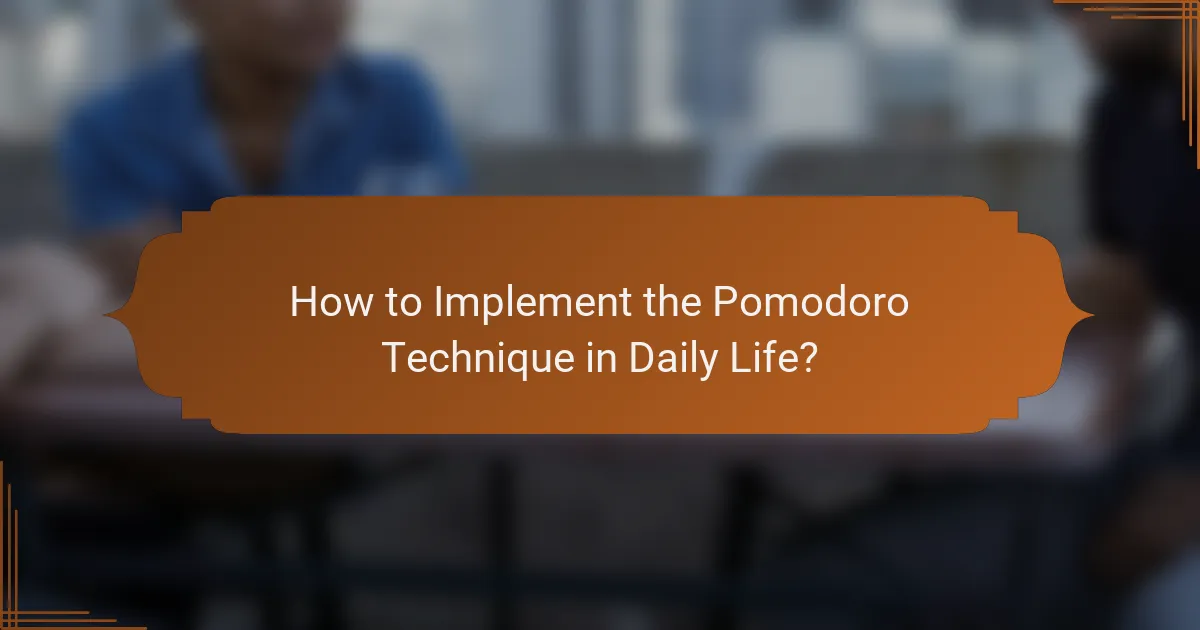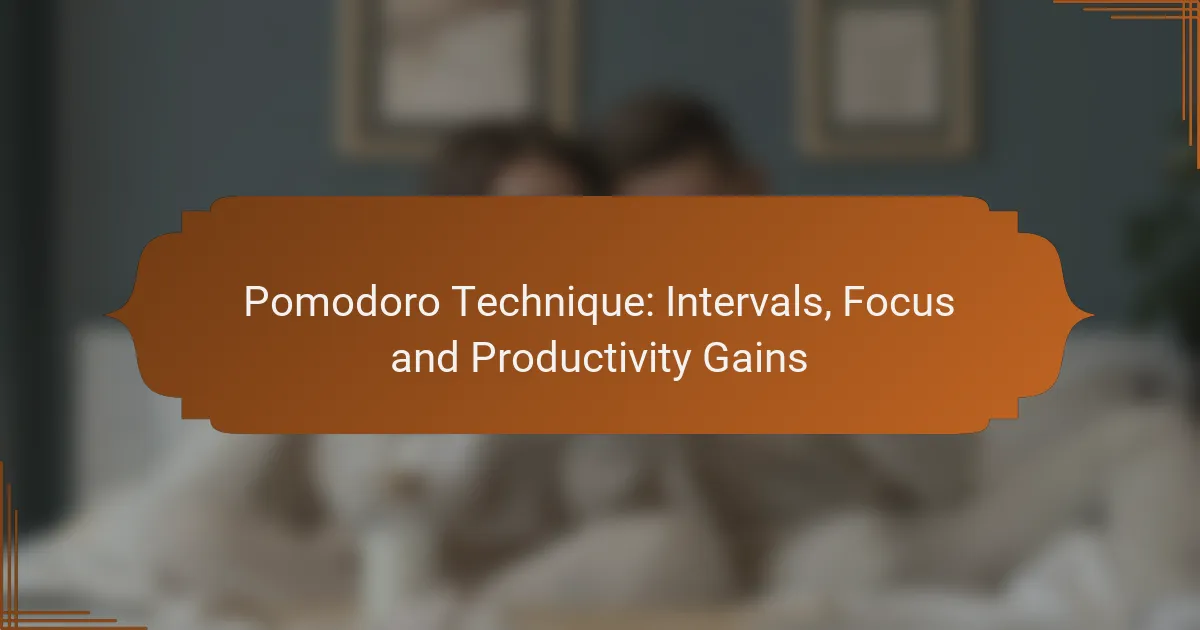The Pomodoro Technique is a time management method that boosts productivity by dividing work into focused intervals, typically lasting 25 minutes, followed by short breaks. This structured approach not only enhances concentration but also helps to prevent mental fatigue, making it easier to maintain high levels of productivity throughout the day.

How Does the Pomodoro Technique Improve Focus?
The Pomodoro Technique enhances focus by breaking work into manageable intervals, typically 25 minutes, followed by short breaks. This structured approach helps maintain concentration and reduces mental fatigue, leading to improved productivity.
Enhances concentration
The Pomodoro Technique promotes deep concentration by encouraging users to focus solely on one task during each interval. By committing to a short, defined period of work, distractions are minimized, allowing for a more immersive experience.
To maximize concentration, choose a specific task before starting your Pomodoro. This clarity helps eliminate decision fatigue and keeps your mind focused on the task at hand.
Reduces distractions
By design, the Pomodoro Technique reduces distractions through its structured intervals and breaks. During the 25-minute work sessions, it is crucial to silence notifications and set boundaries with others to maintain focus.
Consider using tools like website blockers or apps that limit distractions during your Pomodoro sessions. This proactive approach can significantly enhance your ability to concentrate on your work.
Increases motivation
The Pomodoro Technique can boost motivation by providing a clear framework for progress. Completing each Pomodoro gives a sense of accomplishment, which can encourage continued effort throughout the day.
To further enhance motivation, track your completed Pomodoros and set small rewards for achieving milestones. This practice can create a positive feedback loop, reinforcing your productivity habits over time.

What Are the Key Intervals in the Pomodoro Technique?
The Pomodoro Technique is structured around specific intervals that enhance focus and productivity. The key intervals include 25-minute work sessions, short breaks, and longer breaks after completing multiple sessions.
Standard 25-minute work sessions
The core of the Pomodoro Technique is the 25-minute work session, known as a “Pomodoro.” During this time, you focus entirely on a single task without interruptions. This duration is designed to maintain high levels of concentration while preventing burnout.
To maximize effectiveness, choose a task that can be realistically completed or progressed within this timeframe. If you find yourself distracted, consider using tools like website blockers to help maintain focus.
5-minute breaks
After each 25-minute work session, take a 5-minute break to recharge. This brief pause allows your mind to rest and helps maintain productivity over time. Use this time to stretch, hydrate, or engage in a quick, unrelated activity.
Be mindful not to extend these breaks too long, as it can disrupt your workflow. Setting a timer can help ensure you return to your next Pomodoro promptly.
Longer breaks after four sessions
After completing four Pomodoros, take a longer break of 15 to 30 minutes. This extended break is crucial for mental recovery and helps prevent fatigue. Use this time to relax, take a walk, or enjoy a snack to rejuvenate your energy levels.
Incorporating longer breaks into your routine can significantly enhance overall productivity. It allows you to return to your tasks with renewed focus and clarity, making it easier to tackle more complex challenges.

What Tools Can Enhance the Pomodoro Technique?
Several tools can significantly enhance the effectiveness of the Pomodoro Technique by improving focus, managing tasks, and tracking time. Utilizing the right applications can streamline your workflow and help maintain productivity during work intervals.
Focus@Will for music
Focus@Will is a music service designed to improve concentration and productivity. It offers a variety of music channels specifically curated to enhance focus during work sessions, making it a great companion for the Pomodoro Technique.
By selecting music that aligns with your work style, you can create an optimal auditory environment. Consider experimenting with different genres to find what helps you concentrate best, as personal preferences can vary widely.
Trello for task management
Trello is a visual task management tool that helps you organize your projects and tasks effectively. Using Trello in conjunction with the Pomodoro Technique allows you to break down larger tasks into manageable chunks, aligning perfectly with the timed intervals.
Create boards for different projects and use cards to represent tasks. This visual representation can help you prioritize your work and track progress, making it easier to stay focused during each Pomodoro session.
Tomato Timer for tracking
Tomato Timer is a simple online timer specifically designed for the Pomodoro Technique. It allows you to easily set work intervals and breaks, ensuring you adhere to the structured timing that the method promotes.
This tool is user-friendly and requires no installation, making it accessible from any device. Consider using Tomato Timer to keep your sessions on track, and remember to adjust the timer settings if you find that your focus varies during different tasks.

How to Implement the Pomodoro Technique in Daily Life?
The Pomodoro Technique can be effectively integrated into daily routines by breaking work into focused intervals, typically 25 minutes long, followed by short breaks. This method enhances concentration and productivity while preventing burnout.
Identify tasks
Start by listing the tasks you need to accomplish. Prioritize them based on urgency and importance, which can help you focus on what matters most. Breaking larger projects into smaller, manageable tasks can also make them less daunting and easier to tackle.
Consider using a task management tool or a simple notepad to keep track of your to-do list. This visual representation can help you stay organized and motivated as you check off completed items.
Set a timer
Once you’ve identified your tasks, set a timer for 25 minutes to begin your focused work session. Use a physical timer, a smartphone app, or an online timer to keep track of your intervals. The key is to commit fully to the task during this time without distractions.
After the timer goes off, take a 5-minute break to recharge. This could involve stretching, grabbing a snack, or simply stepping away from your workspace. After completing four Pomodoros, take a longer break of 15-30 minutes to refresh your mind.
Review progress
At the end of your workday, take a moment to review what you accomplished during your Pomodoro sessions. Reflect on which tasks were completed and how effectively you managed your time. This review can help you identify patterns in your productivity and areas for improvement.
Consider keeping a log of your Pomodoros to track your progress over time. This can provide insights into your work habits and help you adjust your approach for better efficiency in future sessions.

What Are the Benefits of Using the Pomodoro Technique?
The Pomodoro Technique offers several benefits, including enhanced focus, improved productivity, and better time management. By breaking work into intervals, typically 25 minutes long, followed by short breaks, individuals can maintain concentration and reduce mental fatigue.
Boosts productivity
The Pomodoro Technique significantly boosts productivity by encouraging sustained focus during work intervals. This method helps to minimize distractions and promotes a sense of urgency, making it easier to complete tasks efficiently.
For example, if you have a project that typically takes several hours, breaking it down into 25-minute segments can help you tackle it in manageable portions. This approach can lead to completing more tasks in a day compared to traditional methods.
Improves time management
Using the Pomodoro Technique enhances time management by providing a structured approach to work. Each interval allows you to allocate specific time slots for tasks, making it easier to prioritize and track progress.
To effectively implement this technique, consider using a timer to signal the start and end of each Pomodoro. After completing four intervals, take a longer break of 15-30 minutes to recharge. This rhythm helps maintain a balanced workflow and prevents burnout.
